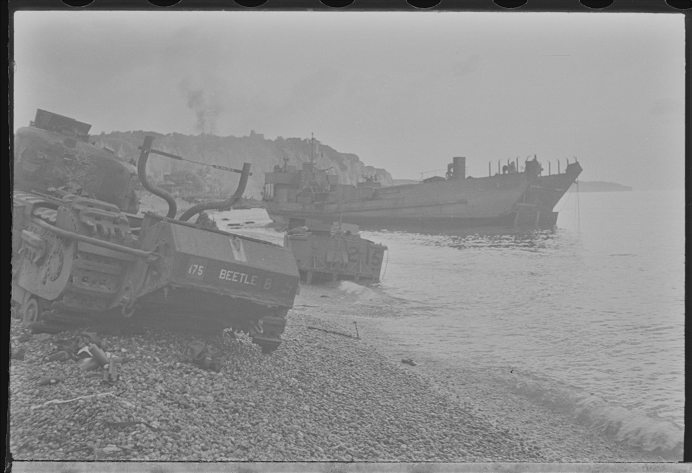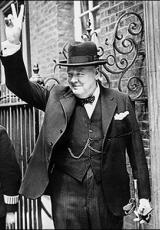Operation Jubilee, Dieppe – 19 August 1942
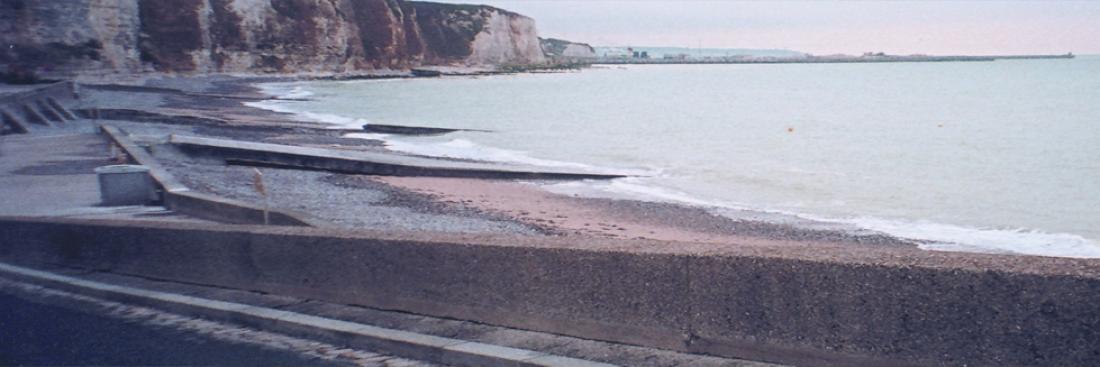
With the German attack on the Soviet Union on 22 June 1941, the Japanese aggression on the American base at Pearl Harbor the following 7 December and the United States' subsequent entry into the war, the conflict became a World War.
At the start of 1942, the Axis forces - Germany, Italy and Japan - were victorious on all fronts. The Soviets, in particular, were in serious difficulty against the German troops. They wanted the Allies to open up a new front in the West to provide them with some relief. The state of the Allied forces, however, made it impossible for them to envisage any landing in Europe before 1943.
The German defence system in the West put to the test
Raids on Bruneval and Saint Nazaire in February and March 1942 inflicted significant losses on the enemy, notably with the destruction of a new-generation German radar. The Allies then envisaged the possibility of a large-scale operation on the French coast, designed to put the German defence system in the West to the test.
They decided on Dieppe, a port in the Upper Normandy region, fairly close to Great Britain, which made continuous air cover possible. Moreover, the German defences in the region were considered to be less dangerous than those on the Pas de Calais coast. The landscape in the area is quite rugged, characterised by high, nearly impenetrable cliffs if coming from the sea, limiting the number of intervention sites.

The coast at Dieppe features high cliffs that are nearly impenetrable except at the mouths of the ”valleuses”. Source: DR
An action plan was drawn up by the Allied High Command in April.
The purpose of the operation, which was then called ”Rutter”, was to destroy the coastal defences and as much as the strategic infrastructures as possible - airfields, radar stations, electricity plants, port and rail facilities, ammunition and fuel depots - and to seize documents at the German division's headquarters, thought to be located in Arques-la-Bataille.
The plan called for a central attack on Dieppe, preceded by attacks on the flanks, at Puys and Pourville, located on either side of the port, and by airborne attacks on the artillery battery further afield in Berneval and Varengeville. Beforehand, the seafront had to be targeted by aerial bombings. The Canadians were entrusted with executing the plan. The operation was scheduled for 4 July but, due to poor weather conditions, it was postponed and then cancelled in the end.
Very quickly, this project was once again under study. Under the name Operation Jubilee, the plan was revisited with a few changes - no paratrooper interventions and no preliminary bombing. At Varengeville and Berneval, commandos brought in by sea were in charge of neutralising the German artillery batteries. Above and below Dieppe, the attack was handled by troops landing at Puys and Pourville. These landings were scheduled for 4.50 am, and the attack on Dieppe for 5.20 am; the lateral defences were supposed to have fallen to the Allies by that time. The intervention was only supposed to take about ten hours.


Maps of the operations. Source: MINDEF/SGA/DMPA
The troops were under the orders of Captain Hugues Hallett for the naval forces, General Roberts, commander of the 2nd Canadian Infantry Division for the landing forces and Air Chief Marshall Leigh-Mallory for aviation.
The landing forces included some 4,965 Canadians and 1,100 British soldiers along with some fifty American Rangers and a few ”Fighting France” men sprinkled among the Canadian and British units, for a total of more than 6,000 men. The flotilla that was to transport the troops and to ensure their landing comprised nearly 200 ships or landing craft. Eight destroyers, including one flying the Polish flag, made up the expedition's battle forces.
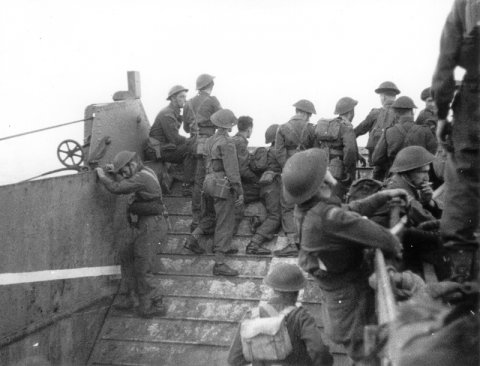
Canadian troops preparing to land. Source: DMPA Collection
Le dispositif de soutien comprend deux canonnières, une trentaine de vedettes et de chaloupes à moteur, ainsi que sept chasseurs de sous-marins français, dont trois armés par la Royal Navy et quatre par les Forces navales françaises libres. L'appui aérien est assuré par près d'un millier d'appareils, essentiellement des chasseurs britanniques et quelques bombardiers américains.
The support system included two gunboats, some thirty patrol boats and motor launches, as well as seven French submarine chasers, including three armed by the Royal Navy and four by the Free French Naval Forces. Air support was provided by nearly one thousand aircraft, essentially British fighters and a few American bombers.
Dieppe was defended by the 302nd German Infantry Division. It has been estimated that there was a total of some 2,000 men spread out over the various landing sites. From Berneval to Varengeville, the front was eighteen kilometres long. Artillery batteries on the hillsides and in the countryside, anti-tank guns, machine-gun nests, blockhouses and miscellaneous fortified structures defended the coastline and the port. Barbed-wire fences and even anti-tank walls and ditches blocked the main beaches. Off the coast, access to the shoreline was defended by a large minefield. Air cover was based on some 400 Luftwaffe aircraft, mainly fighter planes.
On 18 August at 10.00 am, the final execution order was given. The troops embarked during the afternoon at Newhaven, Southampton, Shoreham and Portsmouth in southern England. In the evening, the landing force vessels raised anchor.
On 19 August at around 3.00 am, the landing operations began. The men in the first four assault waves boarded the barges designed to transport them to their respective landing sites. Everything went well until the gunboat opening the route for No. 3 Commando, which was supposed to land on the beaches of Berneval and Belleville-sur-Mer, found itself confronted with a German convoy from Boulogne. A clash ensued. The British unit suffered serious losses in terms of men and materiel, and had to continue operating with limited resources.
No. 3 Commando, which now only had seven boats out of twenty-seven, reached its goal. After landing at Val-du-Prêtre beach in Belleville at 4.45 am, Major Young's nineteen men reached the plateau and managed to neutralise the Berneval artillery battery for an hour and a half. At 8.10 am, running out of ammunition, the men re-embarked. But the operation at Berneval beach was a failure. The English landed under heavy German gunfire. Some one hundred of them rushed onto the beach, where enemy fire made it impossible for them to move forward. At around 10.00 am, blocked at the foot of the cliffs after nearly five hours of fighting, the commandos surrendered without having met up with Young's men.

Patriotic illustrated magazine published in 1948. Source: Private collection
At the other end of the zone of operations, No. 4 Commando was in charge of neutralising the artillery battery at Varengeville-sur-Mer. Divided into two groups, Lieutenant Colonel Lord Lovat's 250 men landed at Vastérival and Quiberville and destroyed the six artillery batteries after taking them at the tips of their bayonets. Having fulfilled their mission without too many losses, the English pulled back and re-embarked at around 7.30 am, taking four German prisoners with them.
At Puys and Pourville, above and below Dieppe, as well as at Dieppe itself, the Canadians executed their operations. Having reached their destination, they came under enemy fire almost everywhere and, for the most part, were pinned down on the beaches.
After landing at Puys fifteen minutes late, the men of the Royal Regiment of Canada were blocked by a wall that cuts the beach in two, providing no protection, and were wiped out during the first minutes of the landing. Only some twenty of them managed to get off the beach. The losses were terrifying - out of some 650 men, 128 were killed and over 250 were taken prisoner. The operation was a total failure. The German defences on the cliff overlooking access to Dieppe were not neutralised.
The South Saskatchewan Regiment and the Queen's Own Cameron Highlanders of Canada landed at Pourville at the scheduled time, without much difficulty. Continuing inland, the men nonetheless came up against increasingly stiff resistance. After taking a few positions, they had to abandon the terrain they had taken and re-embark late in the morning. Losses were heavy; out of one thousand men, barely half managed to re-embark at Pourville.
At 5.20 am, the frontal assault on Dieppe began. The Royal Hamilton Light Infantry and the Essex Scottish landed under a barrage of fire from the German artillery batteries. Most of the Canadians were stuck on the beach while a handful of men managed to take the casino and move into the city. There were too few of them to get very far. The tanks brought in on specially fitted LCTs (landing craft tanks) mostly stayed blocked on the beach. Under enemy fire, they were systematically destroyed and were unable to provide any effective support.

Destroyed boat and tanks. Source: DMPA Collection
Those who managed to reach the esplanade were stopped by the anti-tank systems and were unable to get into the city. The Fusiliers Mont-Royal and the Royal Marines commandos landed to provide reinforcements, but were unable to turn the situation around. In the end, no objectives were taken.
On the beaches there was nothing but desolation. At 9.35 am, the order was given to prepare to evacuate whatever was left to be evacuated.

Repatriating casualties on an Allied ship off Dieppe. Source: DMPA Collection
At 1.30 pm, the last ship left the coast to return to England, leaving some 3,000 men behind them, either dead or imprisoned. Vehicles, equipment and many weapons were abandoned on site. Nine hours after the start of the attack, the operation had left 1,197 men dead or missing, nearly 1,500 wounded and some 2,000 prisoners, most of them from the Canadian ranks (over 900 dead). Thirty-four ships, including one destroyer, and 108 planes had been lost. On the German side, losses were estimated at 350 killed or missing, several hundred wounded and 34 prisoners. The Luftwaffe lost 48 aircraft.

After the operation, some 2,000 Allied soldiers were in German hands. Source: DMPA Collection
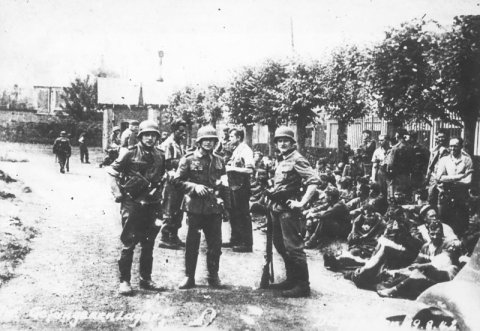
Canadian prisoners. Source: DMPA Collection
The German defences had been underestimated, the air and naval support resources were too weak, ill-suited materiel was used, there was a lack of transmissions, the action plan was too inflexible - these are the most common explanations given for this military failure. These were also dearly-paid lessons that the Allies used in preparing later landings: North Africa, Sicily, Italy and, in the end, Normandy.

Courrier de l'Air pamphlets delivered by the British aviation telling of the operation. Source: DMPA Collection
Summary:
On 19 August 1942, the 6,000 men of Operation Jubilee landed at Dieppe and in the vicinity to destroy the coastal defences and strategic infrastructures. It was a dismal failure for the Canadian, British, American and French Allies trapped by the German Army, but information was obtained that would be invaluable for future landings.

Monument dedicated to the Royal Regiment of Canada and the German blockhouses shooting on sight at Puys beach. Source: Private collection
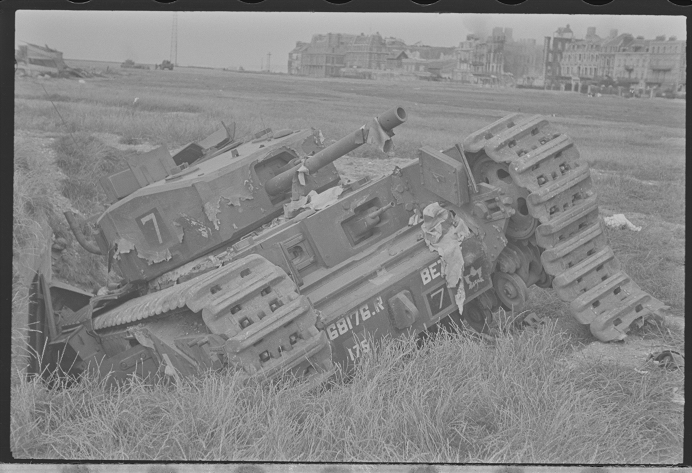
La plage de Dieppe après le tragique débarquement du mercredi 19 août 1942. Les débris des bâtiments de débarquements, barges, engins amphibies se mêlent aux cadavres des soldats canadiens. Le char "Churchill" immatriculé T 68176R baptisé "Betty ».
© Photographe inconnu/ECPAD/Défense
